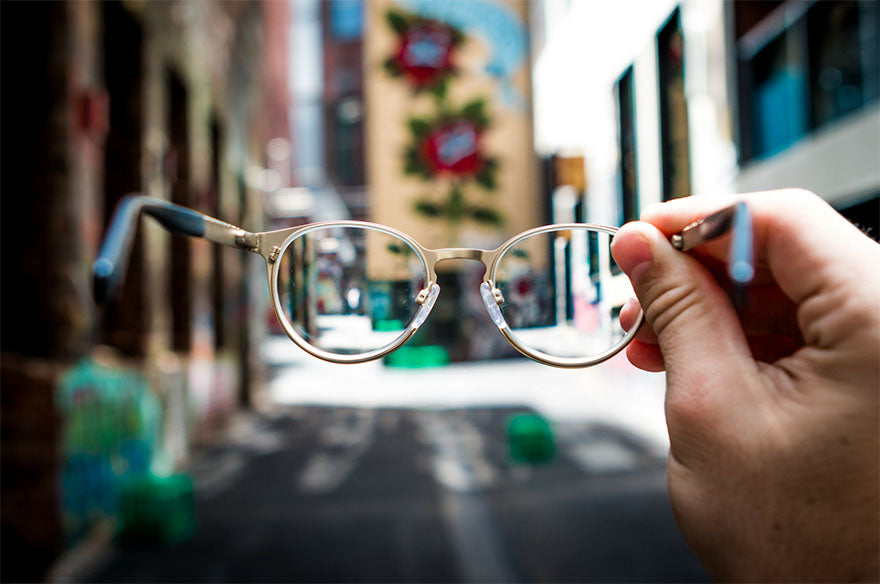Types of Lenses for Sunglasses and Glasses

Choosing new glasses and sunglasses is an important decision. Not only do you have to choose frames that fit your face, and suit your lifestyle, you must also think about choosing the right lenses too. There are almost as many different lens options as there are frame options and, if you’re new to wearing glasses or sunglasses, this can leave you struggling to know which ones to choose. Don’t worry, we’ve done all the work for you!
Here is a comprehensive list of the different types of lenses available for your glasses and sunglasses, and the benefits of each choice:
Popular Types of Lenses
Aspheric
Aspheric lenses are an attractive alternative to conventional lenses, allowing them to be both flatter and thinner. These lenses have a more complex frontal surface that gradually curves from the centre of the lens out to the edge, rather than making use of a perfect sphere. That means that they can be produced in a shape that is easier to wear and looks much better when worn.
If you’re looking for thin but durable glasses, then aspheric lenses are a great choice. Because they are thinner, they are also lighter, making these a good option for individuals who wear their glasses all day, and want frames that are as light as possible.
Bifocal Lenses
If you are both near-sighted and far-sighted then you will need to wear bifocal lenses. These are multi-faceted lenses designed to allow for two different uses in the same frames. The top of the lens is for distance viewing (such as driving) and the bottom half is for close-up work (such as computer work).
Bifocals are an ideal choice for those glasses wearers whose close-up vision has begun to decline due to age. They are also a good choice if you need to wear glasses all the time, and don’t want to have to change your glasses when engaging in different tasks.
Because they are more complex to manufacture, bifocals tend to be more expensive than other types of lenses. It can also take time to get used to wearing them and using them properly. But if you are both near and far-sighted, they are worth the investment of both time and money to completely correct your vision.
Progressive Lenses
If you are both near-sighted and far-sighted then another lens option available to you is to choose a progressive lens. Whilst varifocal lenses have a clear division between the two parts of the lens, progressive lenses have a smooth progression, allowing you to see at both distances without a separating line down the middle of your lens.
These are a great choice for style-conscious glasses wearers who want a chic and modern look. They may be a little more pricey than the other lenses on this list, but it’s worth spending a little more to feel happy and comfortable in the glasses that you will wear every day.
Photochromic Lenses
Photochromic lenses are optical lenses that darken when they are exposed to specific types of light, especially the UV light of the sun. That means that when you wear these lenses indoors you will appear to be wearing normal clear glasses, but the lenses will darken to give you sunglasses when you wear them outside in bright sunglasses.
These versatile frames are a great, no-nonsense choice if you don’t find the idea of carrying both glasses and sunglasses appealing. You are much less likely to lose or damage your glasses or sunglasses when you are carrying them with you, so photochromic lenses will minimise this risk. What’s more, they will provide increased protection for your eyes, because even in low light (where you might not naturally switch to your sunglasses) your glasses will darken, helping to reduce your risk of macular degeneration, cataracts, and other UV related issues.
Photochromic lenses are a popular choice for men and women of all ages. Whilst photochromic lenses may initially seem more expensive than other lens options, they are actually cheaper than the outlay involved in purchasing prescription glasses and sunglasses at the same time.
Polycarbonate Lenses
Do you love to work out, have an active lifestyle, or simply consider yourself to be clumsy? If you need glasses that can keep up with your high-speed lifestyle (and survive a drop or two) then polycarbonate lenses would be the perfect choice.
Lenses made up tough polycarbonate are most popular amongst savvy parents looking for glasses their children won’t break in the playground. They are also a good choice for sports enthusiasts and are a great durable choice if you want to wear rimless frames too. Another benefit of choosing polycarbonate lenses is that they have built-in UV filters, meaning that they can protect you from the sun, and the myriad of eye damage that it can cause. These are lenses that are tough and easy to wear.






